
Universe's Existence May Be Explained by New Material
A special ceramic may help researchers explain why all matter in the universe didn't annihilate shortly after the big bang.
About 13.7 billion years ago, the big bang created a big mess of matter that eventually gave rise to life, the universe, and everything. Now a new material may help scientists understand why.
The material was designed to detect a theorized but unproven property of electrons, subatomic particles with a negative charge that orbit the centers of atoms.
(Related: "Proton Smaller Than Thought—May Rewrite Laws of Physics.")
If this "new" property of electrons exists, scientists say, it would help explain the current imbalance between matter and antimatter in the universe.
"In the early stages of the universe, everything should have been symmetric," said study co-author Marjana Ležaić, a materials scientist at the Forschungszentrum Jülich Institute of Solid State Research in Germany.
Current theories of particle physics state that the big bang should have created equal amounts of particles and antiparticles, which have identical masses and spins but with opposite charges and magnetic properties.
When these "mirrored" forms of matter interact, they cancel each other out in a process called annihilation, leaving behind only pure energy. (Related: "Antimatter-Rocket Plan Fuels Hope for 'Star Trek' Tech.")
"This would mean that if we had exactly the same amounts [of matter and antimatter], then matter would not exist and we would not exist, because everything would annihilate," Ležaić said.
The sheer fact that we're here must mean that matter behaves slightly different than antimatter, so that over time the universe has accumulated more ordinary matter than antimatter.
New Ceramic May Hold Ultimate Answer
The new electron property may help explain the matter-antimatter imbalance. The theory is that electrons have what's called an electric dipole moment, which is similar to the separation between the positive and negative poles of a magnet.
In the case of an electron, which carries only a negative charge, the electric dipole represents an unequal distribution of the charge.
"One can imagine the dipole moment as a slight spatial deformation of this negative charge," Ležaić said. Such a deformation would violate the symmetry between matter and antimatter, making it possible that particles and antiparticles decay—spontaneously turn into other kinds of particles—at different rates.
If that's the case, the theory goes, enough antiparticles may have decayed in the early universe to avoid total annihilation.
(Related: "Particles Larger Than Galaxies Fill the Universe?")
To look for an electron's electric dipole moment, Ležaić and colleagues created the new ceramic, called europium barium titanate. Ceramics—nonmatellic materials made by heating then cooling a substance—can have a variety of properties based on what they're made of.
As described in a paper published online July 18 in the journal Nature Materials, europium barium titanate has a unique blend of magnetic and electric properties not found in other ceramics made to date.
Because of these properties, when scientists apply an electric field to the new ceramic, the electric dipole moments of the electrons—if they exist—should align themselves with the direction of the electric field.
"This is like if you have a magnet and you put it in a magnetic field, it will want to turn so that its magnetic moment is aligned with the magnetic field," Ležaić explained. "The electric dipole moment wants to align itself with the electric field."
Electrons are also known to spin, creating a so-called magnetic moment that gives the material a measurable magnetization.
For reasons of particle symmetry, electric and magnetic moments also want to align. They are, in a sense, "glued together," Ležaić said.
When the electric field is switched on, the electric dipole moments and magnetic moments of the electrons should flip together. To prove the flip occurred, the researchers would expect to detect the material's switched magnetization.
"This changed magnetization will give you information that there is really an electric dipole moment of the electron, because we can use an electric field to manipulate it," Ležaić said.
(Also see "A Blacker Black: Darkest Known Material Created.")
Electron Experiments Underway
Experiments using the new material to detect the theorized property of electrons are now underway at Yale University in New Haven, Connecticut.
(Related: "LHC Gets First Results; Step Toward 'God Particle'?")
To date, however, the team has grappled with side effects "that mimic the properties of the electric dipole moment," Alex Sushkov, a physicist at Yale, said in an email.
For instance, the team has recorded a very slight heating of the material as the electric field is switched on, which changes the magnetic properties of the material. Also, the presence of residual magnetic fields inside the lab can contaminate the results.
"We are modifying our setup to reduce the heating as much as possible as well as shielding [the material from] the external magnetic field," Sushkov said.
Dan Heinzen is a physicist at the University of Texas at Austin who is leading one of several other experiments to detect the electric dipole moment in electrons. He said experiments with the new ceramic "seem promising."
"You never know where progress may happen," Heinzen said via email. "I would expect that you'll see new results from several of these groups over the next few years."








